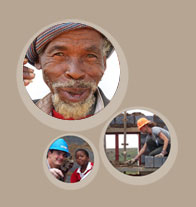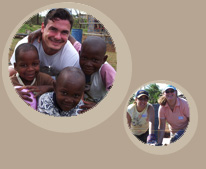


 |
Urbanisation has created a housing crisis around South Africa’s cities. Today 21 million South Africans live in towns and cities. By the year 2010, this is expected to increase to 43.7 million people. This urbanisation is driven by extreme poverty in rural areas with people flocking to the cities in search of employment. Vast informal settlements or townships surrounding its modern cities have rapidly become the most visual expression of urban poverty - thousands of people living without adequate services in overcrowded conditions in shacks that have been pieced together with cardboard, corrugated iron (tin) and scrap wood.
Within such communities children are rendered vulnerable in a variety of ways, including the loss and lack of material security (household income, security of tenure, shelter and physical protection), the lack of food security resulting in hunger and an increased risk of malnutrition, an increased vulnerability to exploitation (violence, sexual abuse, child labour, etc) and an increased likelihood of absenteeism, failure and premature exiting from formal schooling. When male heads-of-household die from AIDS, houses may be sold for cash, grabbed and taken away from the needy family, or abandoned as families are torn apart by AIDS. Surviving widows and orphans may be abused – financially, physically and sexually – if they try to maintain the property, or find themselves living on the street, with all the risks of homelessness. Operational research by the Population Council has shown that orphans are better able to cope with their situation when parents were able to plan for the future by taking steps to select guardians, to protect the inheritance of their children, and to discuss with their children about AIDS illness and death. Protecting the family house is important for the psychological and physical well-being of children. This is especially true for widows and girl orphans, who are both more likely to have their property ‘grabbed’ and are at a higher risk of HIV infection. There is a critical shortage of functional housing - unsanitary, temporary housing conditions, such as mud floors and walls and leaking roofs encourages the spread of illness and disease and threatens the psychological and physical well-being of their occupants. Mud huts or shacks have leaking roofs, crumbling walls, poor sanitation (generally pit latrines), no water or electricity, damp walls and poor ventilation. Not only are these conditions conducive to the spread of the HIV virus and other diseases, but they significantly reduce the likelihood that those who are infected will be able to remain healthy for any length of time. Children living without guardians have special needs, some of which may be met by providing shelter in housing clusters to facilitate care by community volunteers. The “Children on the Brink” (UNAIDS, UNICEF, USAID) report on AIDS orphaning concludes, “Orphanages are not appropriate as a first-line response to the AIDS crisis.” Orphanages require on-going, high levels of expenditure that are beyond the capacity of communities. Additionally, major welfare organisations have found that orphans benefit greatly from the care, personal attention, and social connections that they can receive in family or community care.
|



